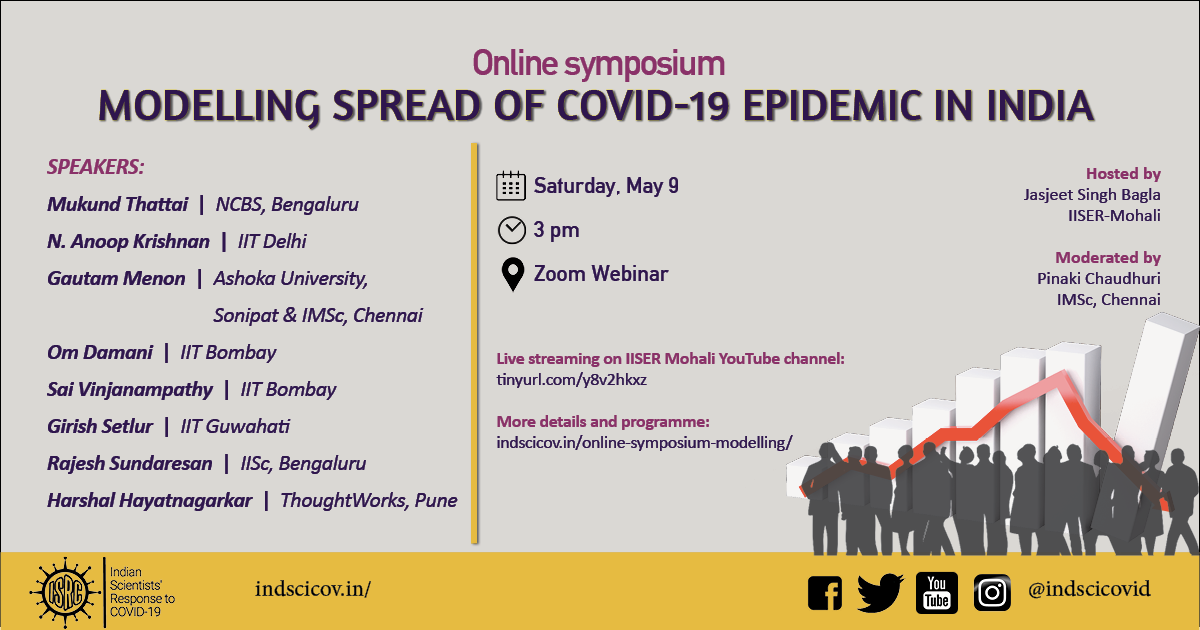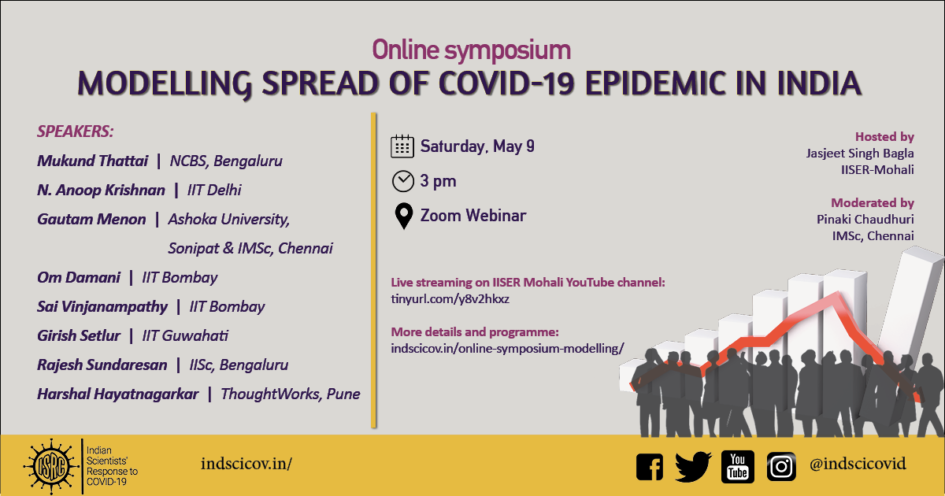Online symposium on Modelling spread of CoVid19 epidemic in India

ISRC is happy to announce the first event in the series of online symposia which focus on the wide range of modelling efforts and data analysis being done by various groups in India, for understanding as well as predicting the spread of CoVid 19 epidemic in India.
The first symposium is scheduled for May 9, 2020, at 3pm
List of speakers
# Mukund Thattai (NCBS, Bangalore)
Spread of Covid-19 in India at successive geographic scales
# N. Anoop Krishnan (IIT Delhi)
PRACRITI: A highly granular model of COVID-19 for effective planning
of control strategies
# Gautam Menon (Ashoka University, Sonipat & IMSc, Chennai)
The INDSCI-SIM model
# Om Damani (IIT Bombay)
Tackling Covid-19: Testing, Tracing, Social Distancing, and Hygiene
# Sai Vinjanampathy (IIT Bombay)
XSEAIPR: Generalised Compartmental model for India-Centric
Interventions against Covid 19
# Girish Setlur (IIT Guwahati)
Modelling and simulation of COVID-19 propagation in a large population with specific reference to India
# Rajesh Sundaresan (IISc, Bangalore)
Unlocking the lockdown in India
# Harshal Hayatnagarkar (ThoughtWorks, Pune)
Early results from a large-scale agent-based simulation of Greater
Mumbai Metropolitan Region
Each presentation will be for 20 minutes, which includes some time for questions. At the end, we will also have a discussion session.
The meeting will be hosted by Jasjeet Singh Bagla (IISER-Mohali) and
will be moderated by Pinaki Chaudhuri (IMSc, Chennai)
Register in advance for this meeting:
https://zoom.us/meeting/register/tJEvfu6spjMsGdJy7zOck64PPxk-4QiN6FPU
After registering, you will receive a confirmation email containing information about joining the meeting.
The symposium will also be live-streamed on the IISER Mohali YouTube Channel: https://tinyurl.com/y8v2hkxz
Abstracts
Spread of Covid-19 in India at successive geographic scales
Mukund Thattai (NCBS, Bangalore)
I will describe a model for the spread of Covid-19 in India, starting from the scale of individuals, through wards, districts and states, to the national scale. I start with contact tracing data to estimate parameters of the infection branching process. I use these within a hierarchical model of spread, based on a modified SEIR framework with an infectivity kernel. At each level of the model the units become exponentially larger in scale; each unit is treated analogous to an infectious individual, but with a renormalized infectivity kernel. I compare the results of the model to data through the month of April. The model predicts a slowing down of the infection rate at successive geographic scales. These predictions qualitatively match patterns seen for the spread of Covid-19 across districts of states, and at the national scale.
PRACRITI: A highly granular model of COVID-19 for effective planning of control strategies
N. Anoop Krishnan (IIT Delhi)
In order to develop effective containment and mitigation measures, prior knowledge on the estimates and transmission dynamics of COVID-19 essential. To address this challenge, we have developed a new adaptive, interacting, cluster-based SEIR model that can predict the trajectory of COVID-19 with high granularity. Specifically, we include the patio-temporal variations of R0 in an adaptive fashion with high granularity of district-wise cases, which allows the model to provide reliable estimates of asymptomatic and undetected COVID-19 cases. With this model, we predict the detailed district-level spread of COVID-19 in India. To disseminate the knowledge, we have developed a web-based dashboard named, Prediction and Assessment of CoRona Infections and Transmission in India (PRACRITI, see: http://pracriti.iitd.ac.in), where the detailed district-wise predictions and R0 values are shared for the benefit of relevant authorities and public.
The INDSCI-SIM model
Gautam Menon (Ashoka University, Sonipat & IMSc, Chennai)
I will summarize the work of the modeling group at ISRC in developing the INDSCI-SIM epidemiological compartmental model for COVID-19 spread. After describing this model in some detail, I will discuss how the model can be used to evaluate the relative merits of different non-pharmaceutical interventions in curbing COVID-19 spread. These include plain lock-downs, staggered lock-downs, “light-switch” lock-downs, quarantine-testing, as well as both periodic synchronous and asynchronous lock-downs.
Tackling Covid-19: Testing, Tracing, Social Distancing, and Hygiene
Om Damani (IIT Bombay)
Based on extensive simulations of our System Dynamics model, we conclude that even after an extended lock-down, some non-trivial number of infections (including asymptomatic ones) will be left and the pandemic will resurface, contrary to the claim in. Only tools that work against the pandemic while keeping the economy open is high rate of testing of those who show Covid-19 like symptoms, isolating them if they are positive and tracing all contacts and quarantining them, in combination with use of face masks and personal hygiene. A range of combination of these measures minimize the pandemic impact, as some imperfections in implementation of one measure get compensated by better implementation of other measures.
Thus, we recommend that, during the current lockdown, appropriate measures should be put in place for intense testing of symptomatic cases, effective contract tracing, isolations, along with increased compliance of other behavioural advice for social distancing.
XSEAIPR: Generalised Compartmental model for India-Centric
Interventions against Covid 19
Sai Vinjanampathy (IIT Bombay)
In this talk, we present a generalised compartmental model to study india centric interventions against COVID-19. We present results from both state- and district-level modelling that incorporates age stratification, healthcare preparedness metrics of states, differential testing rates for states, real time transport data and error bars about expected values using Bayesian estimation techniques.
Modelling and simulation of COVID-19 propagation in a large population with specific reference to India
Girish Setlur (IIT Guwahati)
Deterministic mathematical models (called Compartmental models) of disease propagation such as the SIR model and its variants (MSIR, Carrier state, SEIR, SEIS, MSEIR, MSEIRS models) are used to study the propagation of COVID19 in a large population with specific reference to India.
Unlocking the lockdown in India
Rajesh Sundaresan (IISc, Bangalore)
We present an agent-based city-scale epidemic simulation framework that can be used to compare various un-lockdown strategies. We have used our simulator on Mumbai and Bengaluru for exploration of some scenarios, e.g., graded openings of offices, train services in Mumbai, phased opening with better compliance versus lockdown with lowered compliance, impact of different containment strategies, etc. We will highlight the outcomes of some of these studies.
Early results from a large-scale agent-based simulation of Greater Mumbai Metropolitan Region
Harshal Hayatnagarkar (ThoughtWorks, Pune)
ThoughtWorks has developed ‘EpiRust’, an open-source fast large-scale agent-based simulation framework to model epidemics in cities. Using this framework, researchers can model SEIR/SIR-based diseases such as smallpox, H1N1, and now COVID-19. A researcher can simulate how a disease could spread in a city with a population of up to a few million agents running on commodity hardware like laptops and desktops. EpiRust supports multiple interventions such as mass vaccination, quarantine, and lockdown. ThoughtWorks released EpiRust in open source in late March 2020, and since then we have been collaborating with Dr. Gautam Menon to support multi-city models connected by a transportation network, the Mordecai disease model, and a visualization dashboard. Currently, we are running simulations on the Greater Mumbai metropolitan region with 12 million agents. In this meeting, we will share some early results to have feedback. Going forward, lessons learnt from this implementation will be incorporated into a larger and more complex framework namely BharatSim, via a collaboration between Ashoka University and ThoughtWorks Technologies.
